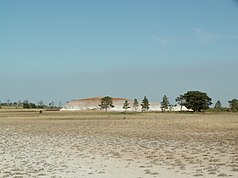Naurzum nature reserve
| Naurzum nature reserve | ||
|---|---|---|
| Naurzum nature reserve | ||
|
|
||
| Location: | Kazakhstan | |
| Next city: | Qostanai | |
| Surface: | 1,913.8 km² | |
| Founding: | 1931 | |
The Naurzum Nature Reserve ( Kazakh Наурызым мемлекеттік табиғи қорығы / Naurysym memlekettik tabighi qoryghy, Russian Наурзумский Государственный Природнный Заповедник / Naursumski Gossudarstwenny Prirodnny Sapowednik) is a nature reserve in the north of the Republic of Kazakhstan . It was founded in 1931 with the aim of protecting part of the Asian steppes. Today, the reserve is of supraregional importance as a rest stop along the important bird migration routes in Eurasia. As part of the northern Kazakh steppe Saryarka, it is a UNESCO World Heritage Site.
geography
The Naurzum nature reserve is located in the Qostanai administrative district in northern Kazakhstan. It extends over wide plains within the Turgai Depression, which are at sea levels of 120-320 m. The area has numerous freshwater and saltwater lakes without drainage, the largest of which are Lake Zharman, Bolshoi Aksuat and Baltaisor. The lakes are up to 3 m deep and are fed by groundwater and rainfall. The most important rivers include the Schochkaly, Akkansaj, Karasu and Danabike. The nature reserve consists of three sub-areas separated by an ecological corridor of approx. 9-14 km: 1) Naurzum (main part), 2) Sypsyn and 3) Tersek.
history
The Naurzum area was inhabited by Kazakh nomads before the nature reserve was established. In the 18th to 19th centuries, numerous natural scientists crossed the area during their expeditions, including well-known researchers such as Alexander von Humboldt . The pine forests of the area passed into the administration of the Russian tsar in 1884. After Kazakhstan was incorporated into the Soviet Union, the Naurzum nature reserve was established in 1931. it is one of the oldest nature reserves in the former USSR and the second oldest in Kazakhstan. The protected area was closed in 1951 and only restored as such in 1966. During this time, his pine forests were placed under collective forest management. After 1966 the area of the protected area was enlarged again and again and an ecological corridor was established between the sub-areas. In 2008, the Naurzum Nature Reserve was conducted as part of the Kazakh Steppe Sary Arka for UNESCO appointed -Weltnaturerbe.
geology
The geological composition of the protected area consists of several layers of sediments, the oldest of which date back to the Paleozoic. The near-surface horizons consist of sandy and loamy sediments from the Oligocene and Miocene . These continental deposits form meter-thick and extensive steps in the wide plains of the area.
Floors
Widespread soils in the nature reserve are loamy and sandy Kastanozeme , Solontschak and Solonetz soils .
climate
The climate of the nature reserve is continental. The winters are cold (mean temperature in January: −17 ° C), there is little rainfall and there are long frosts. The summers, on the other hand, are extremely hot (average temperature in July: 24.2 ° C). The total annual precipitation averages 233 mm, with up to 40% of the annual precipitation falling in summer.
Flora and vegetation
There are 687 plant species known for the nature reserve, including 12 protected species that are registered in the Red Book of Kazakhstan, such as Schrenk's tulip ( Tulipa schrenkii ). In the area there are forest fragments of the common pine , birch and quivering aspen , which are some of the southernmost forest fragments in the steppe region of Kazakhstan. A large area is occupied by the dry steppe or short-grass steppe, in which feather grasses such as the hairy awl grass (Stipa capillata) and the sand feather grass (Stipa borysthenica) dominate. Numerous geophytes bloom here in spring , such as the yellowish pasque flower (Pulsatilla flavescens), Bieberstein's tulip ( Tulipa biebersteiniana ) and Fritillaria meleagroides .
fauna
342 vertebrate species are known for the nature reserve . The number of bird species is particularly high here, also because the area is on one of the most important bird migration routes (282 bird species, 158 of which hibernate). The 44 rare bird species found in the reserve include the Dalmatian pelican , the great white pelican , the young crane and the gray crane . Among the birds of prey are steppe harrier , golden eagle and eastern imperial eagle . A globally rare species that roams in the area is the Siberian crane (Grus leucogranus).

